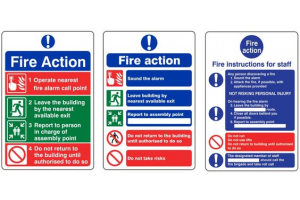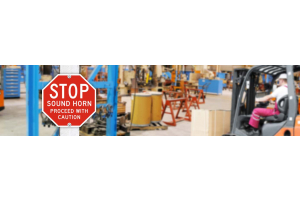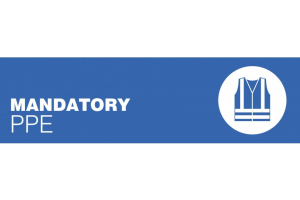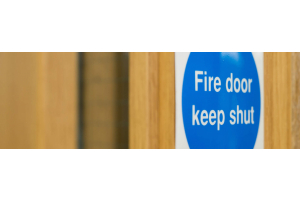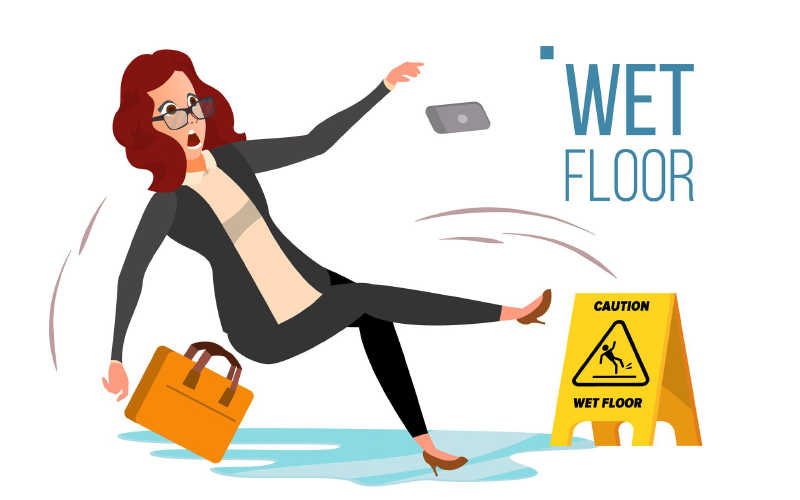
Slips and trips are the most common cause of major injuries at work. Around 90% of these are broken bones. The costs to industry are substantial (over £500 million per year) and there is incalculable human cost and suffering to those injured. Floor cleaning is significant in causing slip and trip accidents, both to cleaning staff and others. Legal actions following an injury can be extremely damaging to business, especially where the public is involved. Insurance only covers a small part of the cost. Effective solutions are often simple, inexpensive and can lead to other benefits.
The most effective approach is to ensure that slips and trips hazards are designed out of a building. Consulting with the cleaners during refurbishment for example, can provide valuable information on the suitability of proposed flooring types and storage facilities for cleaning equipment. This information sheet provides guidance on reducing slips and trips from cleaning activities and will be useful to those who:
- employ or supervise cleaners;
- manage cleaning contracts;
- manage premises where cleaning takes place (either in-house or contracted out);
- are involved in workplace health and safety, for example safety representatives
Slips and trips and the cleaning industry, Floor cleaning is key in controlling many slip and trip accidents because: floor surface contamination (such as water, oil, dust) is often a cause of slip accidents. So, regular cleaning to remove contamination can reduce accidents; cleaning can present slip and trip hazards to those entering the area being cleaned, including the cleaners themselves. For example smooth floors left damp by a mop are likely to be extremely slippery and trailing wires from a vacuum or buffing machine can present a trip hazard; reported major accident figures show cleaning is high risk for slips and trips.
Where cleaning is carried out effectively, it can make the difference between a floor being an unacceptably high slip risk or an acceptably low slip risk. Slip and trip accidents can be serious and costly. Floor cleaning can cause or prevent slips and trips – choose the right method. Simple, inexpensive measures can be effective.
When is someone likely to slip or trip?
Almost all slips happen when floors are wet or dirty (for example contaminated with water, oil, food debris, dust etc). If the floor has a smooth surface (for example the surfaces of standard vinyl, glazed ceramic tiles, varnished wood and some metal floors are all often very smooth) even a tiny amount of contamination can present a real slip problem. Trips generally take place on damaged, uneven and badly laid floors or because obstacles have been left where people do not expect to find them. People rarely slip on clean dry floors. Floors in poor condition and bad housekeeping are responsible for most trip injuries at work.
What can be done to prevent slips and trips? Control measures can be divided into: management systems; contamination control: preventing contamination, choose the right cleaning method, make sure cleaning does not introduce an additional slip risk; obstacle removal. All three are needed to prevent slips and trips.
Management systems
Slips and trips research has shown that cleaning processes are often poorly thought through; and cleaners are rarely involved in deciding how things are done. Cleaning, as with other areas of health and safety, requires a good management system to help you identify problem areas, decide what to do, act on your decisions and check the steps have been effective. A good system should involve: planning to make sure the correct cleaning regime is chosen for the type of floor, taking into account how the floor is used, by whom (for example some people are more at risk such as visually impaired people, the elderly), when it’s used and contaminants present. Consider also how spillages will be cleaned up between the scheduled whole floor cleaning; organising your work and consulting with staff to make sure the planning stage is implemented; control to ensure that working practices and processes are being carried out properly, for example access is prevented to wet smooth floors; monitoring and reviewing to identify any improvements that can be made to the system.
Effective communication is needed at all levels, such as with the: purchasing department to make sure you get what you need, for example equipment and materials; flooring suppliers, who should supply information on their floor and how to effectively clean it; equipment and chemical suppliers to ensure suitability of the product for the type of contaminant and floor; cleaning contractor and client to ensure the contract provides appropriate cleaning by trained cleaners. The contract should be reviewed if the work environment changes; cleaners who need to be consulted on their duties and why the cleaning needs to be undertaken in a particular way or at a particular time. Lack of understanding can lead to inappropriate shortcuts. They should also be informed of any changes.
Effective training and supervision is essential to make sure the standard of cleaning is correct. Training should match the individual, the environment and equipment used. If any of these factors change, training should be reviewed. Cleaners should be encouraged to report any difficulties in carrying out their work. Floors and equipment should be well maintained. People rarely slip on a clean dry floor. There is contamination involved in almost all slip accidents. It can be introduced by the work activity or in fact by the cleaning activity itself.
The best method is to prevent contamination of the dry floor. Spot cleaning is a useful technique to clean up spills etc as they happen, especially between whole floor cleaning. You need to consider who is best placed to do the spot cleaning, for example those working in an area or dedicated cleaners. Further information on spot cleaning is given in ‘Choosing the right cleaning method’. At entrances, enclosed holders for wet umbrellas and effective well-maintained matting can stop the floor getting wet. If contamination is walked beyond the matting, can it be improved? Choosing the right cleaning method. To effectively remove contaminant, the correct cleaning regime needs to be chosen. Consider the factors below when choosing the cleaning technique.
Detergent - is essential if there is any greasy or oily contamination on the floor. Water on its own, whether it is cold or warm, is not effective in removing this kind of contamination. The concentration of detergent is critical to its effectiveness. Follow the manufacturer’s instructions, because too strong a solution can be as ineffective as too weak. Monitoring how much is used can be a useful check. Dosing systems can eliminate error. The detergent should be left on the floor for enough time to allow effective removal of grease before rinsing. A useful comparison is washing-up, heavily soiled pots and pans require soak time in the detergent. Scouring or brushing can increase the effectiveness of detergent.
Spot cleaning - using a paper towel or rag to remove small areas of water-based contamination from the floor. This is a cheap and effective method of removing water-based spills. It avoids spreading the contamination or increasing the slip risk by mopping a large area. Spot cleaning can be used between scheduled whole-floor cleaning to control contamination. For greasy spills, detergent will be required. Mopping - is usually only effective on smoother floors because it only skims the surface of the floor, regardless of the effort used. Even a well-wrung mop will leave a thin film of water which is enough to create a slip risk on a smooth floor. Subsequent use of a dry mop will reduce the drying time but will not eliminate the slip risk. Where smooth floors are mopped, take care to make sure the floor is left to dry completely before pedestrians are allowed access. Consider how dirt is removed from the floor and where it goes. For example use a separate dirty water bucket for wringing the mop out to increase the dirt removal. Greasy floors require contact time with the detergent solution, for example use an immersion mopping technique, where the detergent is put down in one stage, and mopped up after a soak time in a second stage and always consider health & safety in the workplace.
Sweeping brush - on a smooth floor may be adequate to remove dry contaminants. Airborne dust can be created, so this technique should not be used where there are health risks associated with the dust, for example flour, sawdust. Hose/power washer - with sufficient power can be used to remove dusty or doughy contaminants. The floor will be left wet, so should be rough enough not to create a slip risk with the water left behind. Suitable drainage will be required. For greasy contamination, detergent will be required. Squeegee - can be effective in removing excess water after cleaning, to reduce drying time. The floor will not be left dry and will still present a slip risk. If a floor is rough enough to be left wet, the volume of water is not important and a squeegee is unnecessary. Where oily or greasy contamination is present, the squeegee can have the effect of spreading a thin layer of contamination over a wider area, or forcing it into the surface. This may result in a floor that is more difficult to clean. Further reading can be found here.
